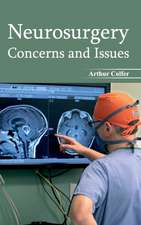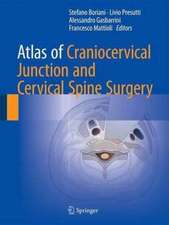Brain Edema XI: Proceedings of the 11th International Symposium, Newcastle-upon-Tyne, United Kingdom, June 6–10, 1999: Acta Neurochirurgica Supplement, cartea 76
Editat de A.D. Mendelow, A. Baethmann, Z. Czernicki, J.T. Hoff, U. Ito, H.E. James, T. Kuroiwa, A. Marmarou, L.F. Marshall, H.-J. Reulenen Limba Engleză Hardback – 29 mai 2001
Din seria Acta Neurochirurgica Supplement
- 5%
 Preț: 1798.83 lei
Preț: 1798.83 lei - 5%
 Preț: 1445.88 lei
Preț: 1445.88 lei - 5%
 Preț: 1102.31 lei
Preț: 1102.31 lei - 5%
 Preț: 1136.85 lei
Preț: 1136.85 lei - 5%
 Preț: 811.16 lei
Preț: 811.16 lei - 5%
 Preț: 1112.70 lei
Preț: 1112.70 lei - 5%
 Preț: 529.81 lei
Preț: 529.81 lei - 5%
 Preț: 791.25 lei
Preț: 791.25 lei - 5%
 Preț: 1303.26 lei
Preț: 1303.26 lei - 5%
 Preț: 410.88 lei
Preț: 410.88 lei - 5%
 Preț: 345.71 lei
Preț: 345.71 lei - 5%
 Preț: 1316.08 lei
Preț: 1316.08 lei - 5%
 Preț: 1452.28 lei
Preț: 1452.28 lei - 5%
 Preț: 1348.49 lei
Preț: 1348.49 lei - 5%
 Preț: 370.94 lei
Preț: 370.94 lei - 5%
 Preț: 376.22 lei
Preț: 376.22 lei - 5%
 Preț: 715.00 lei
Preț: 715.00 lei - 5%
 Preț: 364.17 lei
Preț: 364.17 lei - 5%
 Preț: 365.82 lei
Preț: 365.82 lei - 5%
 Preț: 366.91 lei
Preț: 366.91 lei - 5%
 Preț: 384.08 lei
Preț: 384.08 lei - 5%
 Preț: 397.16 lei
Preț: 397.16 lei - 5%
 Preț: 367.64 lei
Preț: 367.64 lei - 5%
 Preț: 373.12 lei
Preț: 373.12 lei - 5%
 Preț: 993.13 lei
Preț: 993.13 lei - 5%
 Preț: 394.07 lei
Preț: 394.07 lei - 5%
 Preț: 364.74 lei
Preț: 364.74 lei - 5%
 Preț: 1095.90 lei
Preț: 1095.90 lei - 5%
 Preț: 1824.10 lei
Preț: 1824.10 lei - 5%
 Preț: 1119.31 lei
Preț: 1119.31 lei - 5%
 Preț: 1312.12 lei
Preț: 1312.12 lei - 5%
 Preț: 1119.68 lei
Preț: 1119.68 lei - 5%
 Preț: 1331.78 lei
Preț: 1331.78 lei - 5%
 Preț: 1430.72 lei
Preț: 1430.72 lei - 5%
 Preț: 1405.49 lei
Preț: 1405.49 lei - 5%
 Preț: 1418.48 lei
Preț: 1418.48 lei - 5%
 Preț: 392.25 lei
Preț: 392.25 lei - 5%
 Preț: 1335.46 lei
Preț: 1335.46 lei - 5%
 Preț: 1375.23 lei
Preț: 1375.23 lei
Preț: 1088.94 lei
Preț vechi: 1146.25 lei
-5% Nou
Puncte Express: 1633
Preț estimativ în valută:
208.38€ • 222.82$ • 173.73£
208.38€ • 222.82$ • 173.73£
Carte tipărită la comandă
Livrare economică 14-19 aprilie
Preluare comenzi: 021 569.72.76
Specificații
ISBN-13: 9783211835616
ISBN-10: 321183561X
Pagini: 604
Ilustrații: XIX, 572 p. 221 illus., 10 illus. in color.
Dimensiuni: 210 x 279 x 42 mm
Ediția:2000
Editura: SPRINGER VIENNA
Colecția Springer
Seria Acta Neurochirurgica Supplement
Locul publicării:Vienna, Austria
ISBN-10: 321183561X
Pagini: 604
Ilustrații: XIX, 572 p. 221 illus., 10 illus. in color.
Dimensiuni: 210 x 279 x 42 mm
Ediția:2000
Editura: SPRINGER VIENNA
Colecția Springer
Seria Acta Neurochirurgica Supplement
Locul publicării:Vienna, Austria
Public țintă
ResearchCuprins
Imaging: 1H-MR Spectroscopic Monitoring of Posttraumatic Metabolism Following Controlled Cortical Impact Injury: Pilot Study (M. U. Schuhmann, D. Stiller, S. Thomas, T. Brinker, and M. Samii); Heterogeneous Mechanisms of Early Edema Formation in Cerebral Contusion: Diffusion MRI and ADC Mapping Study (T. Kawamata, Y. Katayama, N. Aoyama, and T. Mori); Metabolic Changes in Pericontusional Oedematous Areas in Mild Head Injury Evaluated by 1H MRS (B. C. Son, C.-K. Park, B.-G. Choi, E.-N. Kim, B.-Y. Choe, K.-S. Lee, M.-C. Kim, and J.-K. Kang); Malignancy of Brain Tumors Evaluated by Proton Magnetic Resonance Spectroscopy (1H-MRS) in Vitro (Z. Czernicki, D. Horsztynski, W. Jankowski, P. Grieb, and J. Walecki); rCBF in Hemorrhagic, Non-Hemorrhagic and Mixed Contusions After Severe Head Injury and its Effect on Perilesional Cerebral Blood Flow (B. M. Hoelper, M. M. Reinert, A. Zauner, E. Doppenberg, and R. Bullock).- Molecular Mechanisms: Glutathione Homeostasis and Leukotriene-Induced Permeability in Human Blood-Brain Barrier Endothelial Cells Subjected to in Vitro Ischemia (A. Muruganandam, C. Smith, R. Ball, T. Herring, and D. Stanimirovic); Comparison of NAA Measures by MRS and HPLC (P. P. Fatouros, D. L. Heath, A. Beaumont, F. D. Corwin, S. Signoretti, R. H. AL-Samsam, B. Alessandri, P. Lazzarino, R. Vagnozzi, B. Tavazzi, R. Bullock, and A. Marmarou); Influence of the Bradykinin B1/B2-Receptor-Antagonist B 9428 on the Cerebral Microcirculation and Outcome of Gerbils from Global Cerebral Ischemia (J. Lehmberg, J. Beck, A. Baethmann, and E. Uhl); Evolution of Energy Failure after Repeated Cerebral Ischemia in Gerbils (T. Kuroiwa, U. Ito, Y. Hakamata, S. Hanyu, G. Mies, and D. Hermann); Indomethacin and Cyclosporin a Inhibit in Vitro Ischemia-Induced Expression of ICAM-1and Chemokines in Human Brain Endothelial Cells (W. Zhang, C. Smith, R. Monette, J. Hutchison, and D. B. Stanimirovic); The Selectin Superfamily: The Role of Selectin Adhesion Molecules in Delayed Cerebral Ischaemia After Aneurysmal Subarachnoid Haemorrhage (J. J. Nissen, D. Mantle, A. Blackburn, J. Barnes, T. Wooldridge, B. Gregson, and A. D. Mendelow); Traumatic Brain Injury in Mice Deficient in Poly-ADP(Ribose) Polymerase: A Preliminary Report (M. J. Whalen, R. S. B. Clark, C. E. Dixon, P. Robichaud, D. W. Marion, V. Vagni, S. Graham, L. Virag, G. Hasko, R. Stachlewitz, C. Szabo, and P. M. Kochanek); Increased Immunolocalization of Nitric Oxide Synthases During Blood-Brain Barrier Breakdown and Cerebral Edema (S. Nag, P. Picard, and D. J. Stewart); Biological Functions of Extravasated Serum IgG in Rat Brain (E. Kadota, Y. Muramatsu, K. Nonaka, M. Karasuno, K. Nishi, K. Dote, and S. Hashimoto); Possible Reverse Transport of ß-Amyloid Peptide Across the Blood-Brain Barrier (R. Pluta, A. Misicka, M. Barcikowska, S. Spisacka, A. W. Lipkowski, and S. Januszewski); Reducing Conditions Produce a Loss of Neuroprotective Efficacy of Competitive but not Non-Competitive Antagonists in a Model of NMDA-Mediated Excitotoxicity in Organotypic Hippocampal Slice Cultures (A. K. Pringle, J. Self, and F. Iannotti); Role of Nitric Oxide in Blood-Brain Barrier Permeability, Brain Edema and Cell Damage Following Hyperthermic Brain Injury. An Experimental Study Using EGB-761 and Gingkolide B Pretreatment in the Rat (H. S. Sharma, K. Drieu, P. Alm, and J. Westman); Extracts of Ginkgo Biloba and Panax Ginseng Protect Brain Proteins from Free Radical Induced Oxidative Damage in Vitro (M. S. Siddique, F. Eddeb, D. Mantle, and A. D. Mendelow); p-Chlorophenylalanine, an Inhibitor of SerotoninSynthesis Reduces Blood-Brain Barrier Permeability, Cerebral Blood Flow, Edema Formation and Cell Injury Following Trauma to the Rat Brain (H. S. Sharma, T. Winkler, E. Stälberg, S. Mohanty, and J. Westman); S-100 Serum Levels and Outcome After Severe Head Injury (R. D. Rothoerl, C. Woertgen, and A. Brawanski); A Microstructural Study of Spinal Cord Edema (H. Naruse, K. Tanaka, and A. Kim);






















